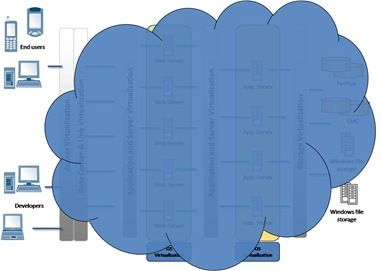application network
2 TopicsDynamic Infrastructure: The Cloud within the Cloud
When folks are asked to define the cloud they invariably, somewhere in the definition, bring up the point that “users shouldn’t care” about the actual implementation. When asked to diagram a cloud environment we end up with two clouds: one representing the “big cloud” and one inside the cloud, representing the infrastructure we aren’t supposed to care about, usually with some pretty graphics representing applications being delivered out of the cloud over the Internet. But yet some of us need to care what’s obscured; the folks tasked with building out a cloud environment need to know what’s hidden in the cloud in order to build out an infrastructure that will support such a dynamic, elastic environment. It is the obscuring of the infrastructure that makes cloud seem so simple. Because we’re hiding all the moving parts that need to work in concert to achieve such a fluid environment it appears as if all you need is virtualization and voila! The rest will take care of itself. But without a dynamic infrastructure supporting all the virtualized applications and, in many cases, infrastructure such an environment is exceedingly difficult to build. WHAT’S HIDDEN IN THE CLOUD Inside the “cloud within the cloud” there are a great number of pieces of infrastructure working together. Obviously there are the core networking components: routers, switches, DNS, and DHCP, without which connectivity would be impossible. Moving up the stack we find load balancing and application delivery infrastructure; the core application networking components that enable the dynamism promised by virtualized environments to be achieved. Without a layer of infrastructure bridging the gap between the network and the applications, virtualized or not, it is difficult to achieve the kind of elasticity and dynamism necessary for the cloud to “just work” for end users. It is the application networking layer that is responsible for ensuring availability, proper routing of requests, and applying application level policies such as security and acceleration. This layer must be dynamic, because the actual virtualized layers of web and application servers are themselves dynamic. Application instances may move from IP to IP across hours or days, and it is necessary for the application networking layer to be able to adapt to that change without requiring manual intervention in the form of configuration modification. Storage virtualization, too, resides in this layer of the infrastructure. Storage virtualization provides enables a dynamic infrastructure by presenting a unified view of storage to the applications and internal infrastructure, ensuring that the application need not be modified in order to access file-based resources. Storage virtualization can further be the means through which cloud control mechanisms manage the myriad virtual images required to support a cloud computing infrastructure. The role of the application networking layer is to mediate, or broker, between clients and the actual applications to ensure a seamless access experience regardless of where the actual application instance might be running at any given time. It is the application networking layer that provides network and server virtualization such that the actual implementation of the cloud is hidden from external constituents. Much like storage virtualization, application networking layers present a “virtual” view of the applications and resources requiring external access. This is why dynamism is such an integral component of a cloud computing infrastructure: the application networking layer must, necessarily, keep tabs on application instances and be able to associate them with the appropriate “virtual” application it presents to external users. Classic load balancing solutions are incapable of such dynamic, near real-time reconfiguration and discovery and almost always require manual intervention. Dynamic application networking infrastructure is not only capable but excels at this type of autonomous function, integrating with the systems necessary to enable awareness of changes within the application infrastructure and act upon them. The “cloud within the cloud” need only be visible to implementers; but as we move forward and more organizations attempt to act on a localized cloud computing strategy it becomes necessary to peer inside the cloud and understand how the disparate pieces of technology combine. This visibility is a requirement if organizations are to achieve the goals desired through the implementation of a cloud computing-based architecture: efficiency and scalability.507Views0likes4CommentsWAN Optimization is not Application Acceleration
Increasingly WAN optimization solutions are adopting the application acceleration moniker, implying a focus that just does not exist. WAN optimization solutions are designed to improve the performance of the network, not applications, and while the former does beget improvements of the latter, true application acceleration solutions offer greater opportunity for improving efficiency and end-user experience as well as aiding in consolidation efforts that result in a reduction in operating and capital expenditure costs. WAN Optimization solutions are, as their title implies, focused on the WAN; on the network. It is their task to improve the utilization of bandwidth, arrest the effects of network congestion, and apply quality of service policies to speed delivery of critical application data by respecting application prioritization. WAN Optimization solutions achieve these goals primarily through the use of data de-duplication techniques. These techniques require a pair of devices as the technology is most often based on a replacement algorithm that seeks out common blocks of data and replaces them with a smaller representative tag or indicator that is interpreted by the paired device such that it can reinsert the common block of data before passing it on to the receiver. The base techniques used by WAN optimization are thus highly effective in scenarios in which large files are transferred back and forth over a connection by one or many people, as large chunks of data are often repeated and the de-duplication process significantly reduces the amount of data traversing the WAN and thus improves performance. Most WAN optimization solutions specifically implement “application” level acceleration for protocols aimed at the transfer of files such as CIFS and SAMBA. But WAN optimization solutions do very little to aid in the improvement of application performance when the data being exchanged is highly volatile and already transferred in small chunks. Web applications today are highly dynamic and personalized, making it less likely that a WAN optimization solution will find chunks of duplicated data large enough to make the overhead of the replacement process beneficial to application performance. In fact, the process of examining small chunks of data for potential duplicated chunks can introduce additional latency that actual degrades performance, much in the same way compression of small chunks of data can be detrimental to application performance. Too, WAN optimization solutions require deployment in pairs which results in what little benefits these solutions offer for web applications being enjoyed only by end-users in a location served by a “remote” device. Customers, partners, and roaming employees will not see improvements in performance because they are not served by a “remote” device. Application acceleration solutions, however, are not constrained by such limitations. Application acceleration solutions act at the higher layers of the stack, from TCP to HTTP, and attempt to improve performance through the optimization of protocols and the applications themselves. The optimizations of TCP, for example, reduce the overhead associated with TCP session management on servers and improve the capacity and performance of the actual application which in turn results in improved response times. The understanding of HTTP and both the browser and server allows application acceleration solutions to employ techniques that leverage cached data and industry standard compression to reduce the amount of data transferred without requiring a “remote” device. Application acceleration solutions are generally asymmetric, with some few also offering a symmetric mode. The former ensures that regardless of the location of the user, partner, or employee that some form of acceleration will provide a better end-user experience while the latter employs more traditional WAN optimization-like functionality to increase the improvements for clients served by a “remote” device. Regardless of the mode, application acceleration solutions improve the efficiency of servers and applications which results in higher capacities and can aid in consolidation efforts (fewer servers are required to serve the same user base with better performance) or simply lengthens the time available before additional investment in servers – and the associated licensing and management costs – must be made. Both WAN optimization and application acceleration aim to improve application performance, but they are not the same solutions nor do they even focus on the same types of applications. It is important to understand the type of application you want to accelerate before choosing a solution. If you are primarily concerned with office productivity applications and the exchange of large files (including backups, virtual images, etc…) between offices, then certainly WAN optimization solutions will provide greater benefits than application acceleration. If you’re concerned primarily about web application performance then application acceleration solutions will offer the greatest boost in performance and efficiency gains. But do not confuse WAN optimization with application acceleration. There is a reason WAN optimization-focused providers have recently begun to partner with application acceleration and application delivery providers – because there is a marked difference between the two types of solutions and a single offering that combines them both is not (yet) available.908Views0likes2Comments

